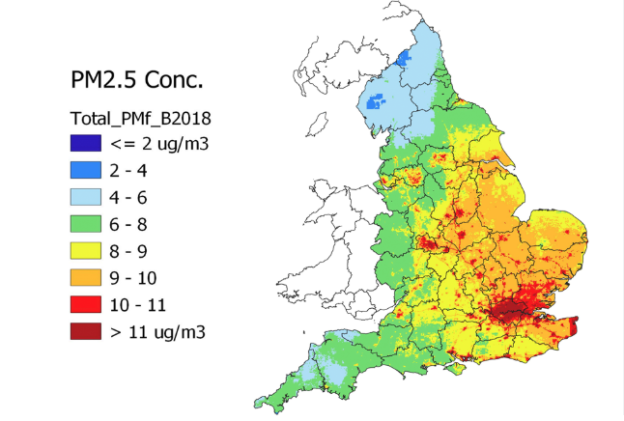New DEFRA data shows that, unlike other major UK cities, London met air quality standards for the first time in 2024.
This means that almost 10 million people are now breathing cleaner air, fewer children are growing up with stunted lungs and fewer people will have to suffer from asthma, dementia and heart disease, which means big savings for the NHS.
But whats is being done in the rest of the UK? Here’s a fairly up–to-date picture of air pollution initiatives in the UK: what’s been done recently, what is being planned, what goals are in place, and some of the challenges/status.
Key Government Strategies & Legal Targets
-
Air Quality Strategy: Framework for Local Authority Delivery (England, 2023)
-
Published by Defra in April 2023; updated in August.
-
Sets out what local authorities are expected to do to improve air quality in their areas, especially for PM₂.₅ (fine particulate matter).
-
Legally binding UK-wide targets include:
• An annual mean PM₂.₅ concentration of 10 µg/m³ by 2040, with an interim target of 12 µg/m³ by January 2028.
• A 35% reduction in average population exposure to PM₂.₅ by 2040, with a 22% reduction by January 2028, based on 2018 baseline.
-
-
National Air Pollution Control Programme (NAPCP)
-
The UK has committed (under the Environment Act and pre-existing legal obligations) to reduce emissions of key pollutants including nitrogen oxides, sulphur dioxide, ammonia, and particulates. These are tied into domestic and international commitments. Local authorities are expected to use existing powers to help deliver on them.
-
-
Clean Air Strategy & Clean Air Goals Based on WHO Guidelines
-
The UK government has made progress on aligning some goals with WHO guidelines. For example, it has committed to halve by 2025 the number of people living in areas that breach WHO guidelines on particulate matter.
-
The Clean Air Strategy remains the overarching framework for emissions from transport, industry, homes etc.
-
Local / Regional Measures & Examples
-
London
-
Expanded Ultra Low Emission Zone (ULEZ) in 2023 to all London boroughs. Studies show substantial drop in NO₂ and particulate pollution since expansion.
-
Roll-out of air quality alerts: London has a system for forecasting pollution episodes; since 2018 there have been “high” and “moderate” alerts issued, and newest work includes notifying healthcare professionals directly.
-
Breathe London: network of hyper-local sensors (~400) to better monitor air pollution.
-
-
Clean Air Zones (CAZ / Low-Emission Zones, Zero Emission Zones)
-
Oxford has the UK’s first zero emission zone (ZEZ) in its city centre, launched February 2022, and is increasing its charges.
-
Bradford’s Clean Air Zone (implemented Sept 2022) shows benefits: for e.g., savings to the NHS, reductions in pollution.
-
Other areas like York have local Air Quality Action Plans (AQAPs) involving measures like electric buses, increased charging infrastructure etc.
-
-
Local Authority Support & Funding
-
The government has allocated funding (Air Quality Grant) to local authorities to deliver projects to improve air quality in their areas: schools, businesses, communities.
-
As of March 2025, there was a review (AQIS review) aimed at improving public awareness, making air quality more part of everyday conversation, improving information to at-risk groups.
-
In the West Midlands, a £1 million regional plan was launched covering things like real-time sensors, awareness campaigns, research into speed-limit reduction etc.
-
-
Non-transport Sources & Broader Measures
-
Recognizing that transport isn’t the only source: homes (heating, boilers), industry, construction, shipping etc are also addressed. For example, London studies have shown that gas boilers are now a major source of NOₓ in central areas.
-
Port of London Authority (PLA) has an updated 2024 strategy, including tracking shipping emissions (using a Maritime Emissions Portal), working with vessel operators, exploring shore-side emissions, targeting hotspots.
-
Public Awareness & Regulatory Tools
-
The AQIS (Air Quality Information System) review published in March 2025 recommends better communication to the public: clearer explanation of health risks, better engagement with at-risk groups, schools, health sector.
-
Local Authorities are required to report via LAQM (Local Air Quality Management) portals etc. The Emissions Factors Toolkit has been updated.
Progress & Outcomes
-
Improvements seen in London since ULEZ expansion: NO₂ down substantially; particulate improvements.
-
Bradford clean air zone shows both pollution and health care cost benefits.
-
Many local authorities are developing or updating Air Quality Action Plans (e.g. York, Oxford etc).
Challenges & Gaps
-
Some delays and criticisms: for example, whether funding is sufficient and consistent. There are calls (from NGOs / coalitions) for a sharper, more enforceable Clean Air Act.
-
Achieving the stricter WHO guideline levels is hard, especially for PM₂.₅, which arises from many diffuse sources (some outside local authority control)
-
Non-transport sources like domestic heating / boilers, shipping, and industrial emissions are becoming proportionally more important as vehicle emissions fall – these present policy and technical challenges
-
Awareness still low in many places; some at-risk groups are still not well served by alerts / information. Communicating risk, and embedding air quality into planning / building / public health is a work in progress.
